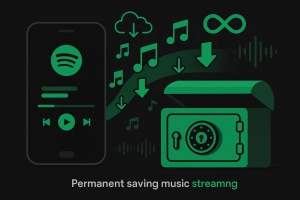Ever bought a song you can’t play on your favorite device? Downloaded a movie that “expired” despite paying for it?
Welcome to DRM—Digital Rights Management. It controls what you do with digital content you’ve purchased: which devices play your music, how many times you watch that movie, whether you can share that eBook.
The frustrating part? DRM claims to stop piracy but mainly annoys paying customers. Pirates crack it in hours while you deal with restrictions.
This guide explains what DRM is, how it works, and how it affects your digital life.
In This Article:
What Is DRM? (And Why It Probably Annoys You)
DRM is technology that controls access to digital content after you’ve bought it.
Think of it like buying a car, but the manufacturer keeps the keys. They decide when you can drive, which roads you can take, and who can ride along. Sounds absurd for a car, right? But that’s how digital content works.
I learned this the hard way when I bought a textbook PDF for college. The DRM let me open it exactly 20 times—after that, my $80 textbook became a paperweight. That’s when I started actually reading the fine print before clicking “buy.”
The Simple Definition
DRM uses encryption, product keys, and access controls to manage copyrighted content. When you download a protected song or movie, you’re not buying it—you’re licensing it under specific conditions: which devices can play it, how many times you can access it, whether you can copy it, and when your access expires.
Critics call it “Digital Restrictions Management,” which feels more accurate.
Why It Exists
Digital files copy perfectly without quality loss. Unlike cassette tapes that degraded with each copy, MP3s and MP4s can be duplicated endlessly with no degradation. Combined with the internet, unauthorized distribution became incredibly easy. DRM emerged as the industry’s answer—though whether it works is debatable.
A Brief History: How We Got Stuck With DRM
DRM evolved alongside digital media, with plenty of spectacular failures along the way. Looking back, it’s almost amusing how badly some of these attempts backfired.
Early DRM (1980s-1990s)
The first DRM system appeared in 1983 in Japan. Early games used low-tech DRM: pause and ask you to look up page 47 of the manual. No manual? No playing.
DVD encryption (CSS) came in the mid-1990s. It worked until 1999 when Jon Lech Johansen released DeCSS for Linux playback. The cat-and-mouse game had begun.
The DMCA Era (1998-2009)
In 1998, the U.S. passed the Digital Millennium Copyright Act, making DRM circumvention illegal—even on content you own.
The 2000s brought peak DRM frustration. Sony’s 2005 rootkit scandal stands out: they secretly installed DRM software via music CDs that created security vulnerabilities. Class action lawsuits followed.
Then came Amazon’s Orwellian moment in July 2009—remotely deleting purchased copies of George Orwell’s 1984 from Kindles. The irony wasn’t lost on anyone.
But major publishers also abandoned music DRM. EMI stopped in 2007, stating “costs don’t measure up to results.” Apple removed it from iTunes by 2009.
Modern DRM (2010-Present)
Today’s landscape differs sharply. Music downloads are mostly DRM-free, but streaming services use it extensively.
Gaming went the opposite direction. Ubisoft’s always-online DRM locked out paying customers when servers went down.
Louis C.K.’s 2011 DRM-free comedy special profited within 12 hours, proving respecting customers works.
How DRM Actually Works (The Technical Stuff Made Simple)
DRM combines several technologies to control your content. Let me break down what’s happening behind the scenes—without the tech jargon that usually makes eyes glaze over.
Core Technologies Behind DRM
Encryption scrambles content. Only proper decryption keys make it usable.
Product keys and activation check validity before authorizing use. Some verify online to prevent multi-device abuse.
Always-on authentication constantly verifies your license. Server down? No playing, even for single-player mode.
Device limits restrict access. Spotify allows 5 devices. Apple Music permits 10.
Watermarking embeds invisible markers. iTunes adds your email to purchases, tracing leaks.
What DRM Can Actually Control
DRM can block copying, prevent sharing (even with family), disable printing, block screenshots, set expiration dates, enforce regional restrictions, and lock content to specific devices.
I once bought an $80 PDF textbook with DRM allowing only 20 opens. After that? Useless. Learned my lesson about reading restrictions before buying.
Common DRM Systems You Encounter Daily
You interact with these constantly, probably without even realizing it. Here’s a quick comparison of the major players:
| DRM System | Used By | What It Protects | Pain Point |
|---|---|---|---|
| Apple FairPlay | iTunes, Apple TV+, iBooks | Movies, TV, audiobooks, apps | Can’t leave Apple ecosystem |
| Google Widevine | Netflix, YouTube, Disney+ | Streaming video content | Can’t download permanently |
| Microsoft PlayReady | Xbox, Windows Media | Games, video, music | Device compatibility limits |
| Adobe DRM | Libraries, publishers | PDFs, eBooks | Auto-expires borrowed books |
| Denuvo | PC games | Game piracy | Performance hit, slower loading |
| HDCP | HDMI connections | Video signals | Can’t record gameplay |
The pattern? Each system trades your convenience for content protection. Whether that trade-off is fair depends on your perspective—and honestly, your patience level.
Where DRM Hits You Every Day (Real Examples)
Streaming Services: When Your Music and Shows Vanish
Netflix downloads expire after 30 days, or 48 hours after starting playback. Can’t transfer them, watch after subscription ends, or back them up.
I learned this on a 14-hour flight to Tokyo. Downloaded six episodes, but they expired mid-flight because I’d “tested” one three days earlier. Spent hours staring at the seat ahead.
Spotify’s offline mode works similarly. Downloads vanish when you stop paying. It’s like renting your own music collection.
For permanent access, Spotify recorders offer legal workarounds by capturing audio as it plays—like recording radio.
Gaming DRM: When You Can’t Play What You Paid For
Steam is essentially DRM, though light enough not to interfere with gameplay. You license games, don’t own them.
Always-online DRM proved disastrous. When Ubisoft’s servers got DDoS attacked in 2010, 5% of customers couldn’t play their $60 games.
Some developers got creative. Serious Sam 3 spawned an invincible pink scorpion to chase pirates. Operation Flashpoint turned them into birds. At least they had humor about it.
Denuvo hurts performance. Tests show games run better after removal. You’re paying for artificially degraded products.
eBooks: Your Library Isn’t Really Yours
Physical books can be borrowed, resold, passed down. Digital books? Amazon’s Kindle DRM locks books to Amazon only. Apple’s iBooks work only on iOS and Mac. Libraries face absurd restrictions—some eBooks “expire” after 26 loans.
DRM Beyond Media: Tractors and Coffee Makers
Keurig used DRM chips in coffee pods, blocking third-party options. Customer backlash forced retreat.
John Deere tractors prevent farmer repairs using DRM, claiming farmers only license the software. This sparked the right-to-repair movement.
Philips Hue pushed firmware blocking third-party bulbs. Outcry reversed it. Even phone chargers have had DRM.
The Legal Maze: Can You Actually Break DRM?
Short answer: usually no. But the details get complicated fast.
United States: The DMCA
The Digital Millennium Copyright Act of 1998 makes circumventing DRM illegal, even on content you own. Breaking the lock itself is a crime.
Narrow exceptions exist for research, interoperability, and accessibility. But security researchers legitimately fear legal action—cryptographer Niels Ferguson refused to publish Intel security findings due to DMCA prosecution risks.
Penalties include civil damages and criminal charges. Russian programmer Dmitry Sklyarov was arrested at DEF CON 2001 for presenting Adobe eBook decryption software.
Ironically, the DMCA hasn’t stopped piracy. Circumvention software is everywhere, games get cracked within hours. The law mainly succeeds in threatening researchers and restricting paying customers.
European Union and International Laws
The EU’s Information Society Directive (2001) provides similar protections but is more consumer-friendly.
In 2012, the EU Court ruled reselling digital games is legal. In 2014, they ruled DRM circumvention can be lawful under certain circumstances.
Countries vary widely. Japan allows research exceptions. Israel doesn’t prohibit circumvention. CD Projekt Red’s GOG.com sells only DRM-free games and succeeds commercially, proving alternatives work.
Why Everyone Hates DRM (Except Maybe Lawyers)
The Problems with DRM
You don’t own what you buy. This is the core issue that drives me nuts. You’re licensing temporary access under changeable conditions. Amazon’s 1984 deletion proved this—they literally deleted books customers had paid for.
Legitimate customers suffer while pirates don’t. I’ve watched friends crack Denuvo in a weekend while I dealt with authentication servers going down on launch day.
Pirates cracked Ubisoft’s “uncrackable” DRM within weeks. Paying customers dealt with performance hits and server outages.
Spore (2008) limited installations to three computers. Backlash made it the most pirated game that year—EA’s anti-piracy measures literally created more pirates.
Content vanishes when services close. MSN Music, Yahoo Music Store, Adobe Content Server 3—all shut down, taking customer libraries with them.
My friend lost her entire TV show collection when a streaming service went bankrupt. $200+ worth of content gone overnight.
Locks you into ecosystems. Want to switch from Kindle to a better reader? Your library is locked to Amazon.
Hurts performance. Independent tests showed games running faster after Denuvo removal. You’re paying full price for degraded products.
Even tech leaders criticize it. Bruce Schneier: making files uncopyable is like “trying to make water not wet.” Bill Gates admitted DRM problems consumers. Gabe Newell: “most DRM strategies are just dumb.”
Why Companies Still Push It
Look, I get it—content creation costs serious money. Hollywood blockbusters run $200 million+. AAA games take years. Musicians invest months. These investments need protection, supposedly.
DRM enables business models like subscriptions. Without it, users could download everything from Netflix, then cancel.
Companies face shareholder pressure to “protect IP.” Implementing DRM shows action, even if ineffective. Security theater—looking secure matters more than being secure.
The Research Reality Check
Studies show DRM doesn’t significantly reduce piracy. Research by Gal Oestreicher-Singer and Arun Sundararajan found that relaxing DRM can benefit rights holders because piracy losses are outweighed by increased value to paying customers.
GOG.com, Tor Books, and Louis C.K.’s experiment prove DRM-free content succeeds commercially. If content is good and fairly priced, people pay for it.
The Workarounds: What Actually Works (And What’s Legal)
Important disclaimer: This is for educational purposes only. I’m explaining what exists and how people use it, not recommending you break laws. Violating the DMCA can mean serious legal trouble.
Is Removing DRM Legal?
Usually not in the U.S. and most Western countries.
The DMCA makes circumvention illegal regardless of ownership. Narrow exceptions exist for research and accessibility.
Creating personal backups falls into grey area. Format shifting was common before DRM. Courts have been inconsistent.
Different countries vary. Some European nations allow personal circumvention. Israel doesn’t prohibit it.
The Analog Hole: DRM’s Unfixable Flaw
Here’s what DRM companies hate to admit: the analog hole makes perfect protection impossible.
To hear audio or watch video, digital signals must become analog—light hitting your eyes, sound waves reaching your ears. At that moment, content can be recaptured and re-digitized.
If you can perceive it, you can record it. That’s not a technical limitation—it’s fundamental to how humans consume media.
For audio, this means recording system sound as it plays. Cinch Audio Recorder captures audio directly from your sound card—essentially placing a digital microphone at the output. Since you’re recording playback, not breaking encryption, this sidesteps legal issues.
I’ve used this approach for years to archive streaming music. The quality is excellent—identical to the source since you’re capturing digital audio before it reaches speakers. Quality software automatically retrieves metadata (song titles, artists, album art) and tags files properly.
The analog hole can’t be closed without making content inaccessible. Perfect DRM protection is impossible because content must be perceivable to be consumed.
How Cinch Audio Recorder Works:
- Launch the program on Windows or Mac
- Click Record – ready to capture any audio playing on your computer
- Start playing music from Spotify, Apple Music, or any streaming service
- Done – Cinch automatically splits songs, retrieves metadata (title, artist, album art), and saves properly tagged MP3 files
It uses CAC (Computer Audio Capture) technology tapping your sound card’s output—like plugging headphones to a recorder. Completely legal for personal use.
You can even mute speakers while recording. Cinch captures the digital stream before it reaches speakers, delivering perfect quality in complete silence.
Other Common Tools
Screen recording software like OBS Studio captures video. Audio recorders like Cinch Audio Recorder offer automatic track splitting and metadata retrieval. DVD ripping tools like HandBrake bypass CSS encryption. eBook DRM removal involves Calibre plugins.
Why do these remain available despite DMCA? Enforcement is inconsistent, they have legitimate uses, and many are hosted internationally.
If You’re a Creator: Should You Use DRM?
Maybe you’re on the flip side—you create content and wonder if DRM is worth implementing.
When You Might Actually Need DRM
Content creators selling digital works might want redistribution prevention. Business documents benefit from access controls ensuring only authorized employees access sensitive information. Educational materials are commonly protected. Corporate compliance often requires DRM for HIPAA, GDPR, and CCPA.
Adobe Experience Manager provides comprehensive rights management. Microsoft PlayReady protects streaming media. FileOpen specializes in PDF encryption. Watermarking tools offer less restrictive alternatives.
My Take on DRM for Creators
After years watching this space:
Balance protection with usability. Over-restrictive DRM frustrates customers and can hurt sales more than piracy. Spore proves this definitively.
Consider going DRM-free. Louis C.K., Tor Books, and GOG.com prove DRM-free succeeds. I’ve bought dozens of DRM-free games when I could’ve pirated them—supporting developers I like matters.
Communicate restrictions clearly. Customers hate surprise limitations. Transparency builds trust.
Have backup plans. What happens when your DRM provider closes? I’ve seen creators lose access to their own protected content.
For most independent creators: strong passwords, watermarking, and limited links provide enough protection without DRM headaches.
The Future: Will DRM Ever Actually Work?
What’s Actually Changing in 2025
Blockchain and NFTs promised revolution. Remember when everyone said NFTs would solve digital ownership? That didn’t pan out. NFTs don’t prevent copying, and blockchain adds complexity without fixing fundamental issues.
AI-powered protection uses machine learning to detect unusual access patterns. Whether this works better than previous DRM remains to be seen. My bet? Pirates adapt faster than AI keeps up.
Streaming actually works. Netflix and Spotify reduced piracy through convenience, not better DRM. Most people pay $10-15 monthly for unlimited access rather than deal with sketchy torrent sites. Convenience does the heavy lifting, not technological restrictions.
Right-to-repair is winning. Farmers successfully lobbied for tractor repair exemptions. The movement is expanding to smartphones and appliances. Companies are losing the fight to use DRM for controlling hardware repairs.
Subscription Fatigue Is Real
Juggling multiple $15 streaming services costs $540+ annually. For that money, you could buy content outright—if ownership were possible.
You don’t build a music collection anymore; you rent access to millions of songs.
Alternative Business Models That Work
Crowdfunding platforms fund DRM-free projects. Double Fine Adventure raised $2+ million by promising DRM-free access. “Pay what you want” models like Humble Bundle succeed. Promotional free content drives paid sales—artists release free singles, authors publish sample chapters. Common thread? Trusting customers and providing value.
Conclusion
DRM remains frustratingly paradoxical. Designed to protect creators, it punishes paying fans. Built to stop piracy, it gets cracked in hours. Meant to preserve value, it sometimes destroys content when services shut down.
For audio and video enthusiasts, understanding DRM is essential—it shapes everything we consume digitally. The expansion into hardware (tractors, coffee makers, light bulbs) shows how far corporations push these restrictions.
But there’s good news. Streaming proved convenience beats heavy-handed protection. Right-to-repair is pushing back successfully. More creators choose DRM-free distribution and thrive.
The debate boils down to balance. Creators deserve protection—I’m not arguing against creators getting paid. But consumers deserve to own what they purchase. Technologies respecting both sides exist. Recording-based solutions like Cinch Audio Recorder prove you can build personal music libraries legally without breaking DRM.
My advice: Vote with your wallet. Support DRM-free content—GOG for games, Bandcamp for music. Read fine print before buying. Push back against over-restrictive policies—customer backlash works.
The analog hole isn’t going anywhere. The future might have fairer DRM if we demand it.
FAQs
What does DRM stand for?
DRM stands for Digital Rights Management, technology controlling access to copyrighted digital content like music, movies, eBooks, and software. Critics call it “Digital Restrictions Management” because it limits what you can do with content you’ve purchased.
Is breaking DRM illegal?
Yes, in most countries including the U.S. and EU. The DMCA and Information Society Directive make circumventing DRM illegal, even for legally purchased content. However, recording content through the analog hole (like capturing audio from your sound card) exists in a legal grey area since you’re not actually breaking encryption—you’re just recording what’s playing.
How do I turn off DRM?
You can’t simply disable DRM on protected content. Your options: purchase DRM-free content from platforms like GOG.com (games), Bandcamp (music), or Tor Books (eBooks), or use recording methods that capture content as it plays rather than breaking protective encryption.
Does DRM actually stop piracy?
No. Research consistently shows DRM is largely ineffective at preventing piracy. Pirates crack protection within hours or days while legitimate customers face ongoing restrictions. Streaming services like Spotify and Netflix demonstrate that convenience and fair pricing reduce piracy far more effectively than technological restrictions ever did.
How to remove DRM from music and videos safely?
Recording content as it plays through your sound card is the safest legal approach. Tools like Cinch Audio Recorder capture audio output without breaking encryption, automatically splitting tracks and adding proper metadata. For personal archiving and backup purposes, this method avoids the legal risks of traditional DRM circumvention tools.












